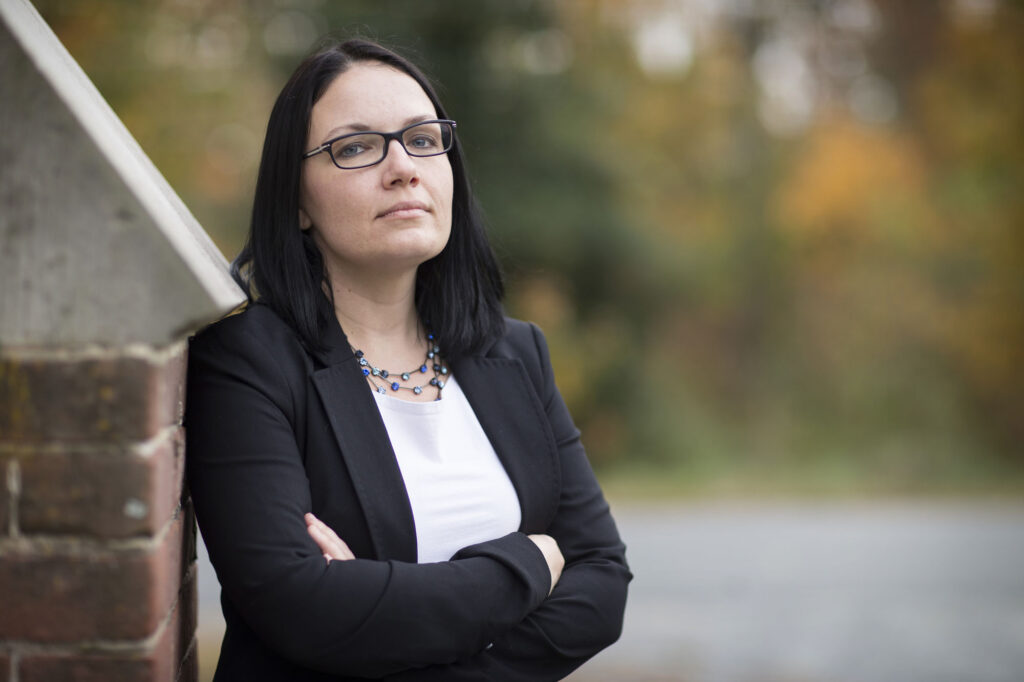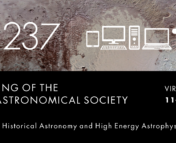In this series of posts, we sit down with a few of the keynote speakers of the 241st AAS meeting to learn more about them and their research. You can see a full schedule of their talks here, and read our other interviews here!

From radio waves to X-rays, Professor Sabrina Stierwalt has harnessed the power of almost the entire electromagnetic spectrum to study galaxy formation and evolution. Dr. Stierwalt likens galaxies to “complex creatures” and believes that “sometimes you just need to look at it from […] the perspective of a different wavelength. And so, as an observer, I’ve always had more questions than can be answered by one wavelength.”
This has led her through an exciting journey in studying the gas dynamics and star formation of galaxies of all sizes. She started out studying massive galaxy mergers in the GOALS survey, looking at luminous infrared galaxies. Soon, she started to wonder if all of the information they were learning about these massive mergers could be scaled down to collisions between smaller dwarf galaxies.
Why does this connection matter? Most astronomers believe that galaxies started out small, merging together continuously to form larger galaxies over cosmic time – so called hierarchical evolution. While we’ve been able to observe and understand mergers between larger galaxies the size of the Milky Way or Andromeda, astronomers don’t have a good grasp of how these earlier stages of hierarchical evolution – ancient mergers between small, dwarf galaxies – play out. And since dwarf galaxies are especially small, faint, and messy, they haven’t been very appealing subjects for astronomers to study.
While other observers might be apprehensive to attempt studying our neighboring galactic building blocks, Dr. Stierwalt welcomes the challenge with a smile. She heads the research program TiNy Titans (TNT), an observational and theoretical study using data from the Sloan Digital Sky Survey to systematically search for these interacting dwarfs and learn about their star formation and gas content. The study is currently underway, but so far their results have pointed to one common theme: dwarf galaxy mergers and massive galaxy mergers are not the same! “We can’t just scale down what we’ve learned about massive galaxy mergers to these low mass galaxy mergers.” While we expect massive mergers to be good at funneling gas into the center of the coalesced galaxy, leading to powerful centralized active galactic nuclei (AGN) and starbursts, the TNT team has found that dwarf mergers seem to be great at throwing gas out and letting it slowly flow back in over time. There’s still a wealth of data to examine, and Dr. Stierwalt is also excited to connect their observational findings with simulations of dwarf mergers to try and piece together how they fit into the puzzle of large-scale structure and galaxy evolution.
In fact, she considers simulations to be a major breakthrough for astronomy during her career. She told me that old simulations were like“…the old arcade games like Pong, with these big galaxy mergers, these big, visible by eye, dark matter particles like you could make them out with your eye right? We went from that to the simulations we see now where you can’t always tell ‘is that a simulated galaxy? Or is it a real image?’ and so that’s been super exciting to see that huge shift just over the span of my career.”
Her current research is not the only area in which Dr. Stierwalt has gone against the current. While growing up on the East Coast, she did not receive a lot of encouragement to pursue a STEM career: “I got a lot of messages that science wasn’t for me, that I wasn’t meant to be good at science or math and I really didn’t like being told what to do, and so I decided to try it anyways. I was also a first-generation college student, and so I didn’t know what was going on ever, so that feeling of being, you know, overwhelmed or potentially not fitting in in physics, I felt that all the time.” Despite this, her love of physics and astronomy led her to the Physics and Astrophysics undergrad program at UC Berkeley, where going to Lick Observatory for the first time cemented her love of observing. “I grew up outside of New York City, where there weren’t any stars, and so having that experience was really, really fundamental for me…seeing the stars, being in the quiet that you have when you’re observing, and also just being in charge of something really expensive,…being trusted as this young person to use this very expensive piece of equipment…someone having that sort of trust in me was also pretty life changing for me because I hadn’t had that before.” She was then accepted to the Astronomy PhD program at Cornell where she worked on the blind HI ALFALFA survey, and went on to do two postdocs and hold a few staff positions, one of which even led to probably one of the coolest jobs for a science PhD: negotiating with Hollywood agents and working with celebrities to highlight NASA mission science!
But after years of research and staff positions, Dr. Stierwalt missed connecting with students, leading her to her current position as an assistant professor at Occidental College, a small Liberal Arts College in Los Angeles. She currently has four undergraduates doing research with her (Occidental doesn’t have graduate students), who get all her best projects and take advantage of all the astronomy activity going on around the LA area.
Besides teaching and research, Dr. Stierwalt also enjoys doing public outreach and science communication. For many years, she wrote content for a weekly science podcast called Everyday Einstein. This podcast answered science questions about everyday curiosities through short episodes, such as how wind energy works or why we draw stars with 5 points. She also created an inflatable planetarium program that lets her and her students visit public schools around LA, giving the opportunity for city kids who don’t see many stars in the polluted skies to get excited about space. Dr. Stierwalt deeply believes in the importance of science communication in getting people excited and comfortable around science, a subject many people fear or think they’re not good at: “astronomy is the science that people can relate to more naturally than a lot of other areas of science. And so we have this super important role where we can get people excited about science, help people connect to science and be more comfortable with that scientific part of their brain…Plus, we spend billions of dollars putting telescopes in space, and so that information belongs to all of us right. The sky belongs to all of us, so I think it’s super important for those of us who have the luxury of being able to think about this stuff all day; being able to communicate that to other people, I think, is super important.”
When asked if there was a piece of advice Dr. Stierwalt would give to herself as a student just starting research, she highlighted the importance of surrounding yourself with supportive peers: “I think I would say that it’s important to find your people. Find your supporters, your colleagues that are your friends, because I think we all have moments when we doubt ourselves…and in those moments I think it’s really important to have someone who you trust that could remind you that you are capable, that you can do these things.”
Though her current research is centered around TiNy Titans, her upcoming plenary lecture at AAS 241 will be aimed at a broader audience in hopes to get more people excited about dwarf galaxies! The talk will cover “…some of the biggest questions that we’ve answered recently about dwarf galaxies or bigger universe questions that we’ve answered with dwarf galaxies and then get into where we’re headed next…some of the next big things that we’ll learn from dwarf galaxies”.
So even if you’re not a dwarf galaxy expert or are just starting to get interested in the field, come hear more at Prof. Sabrina Stierwalt’s plenary lecture, currently scheduled for Wednesday, January 11th at 4:40 pm PT at #AAS241!
Astrobite edited by: Pratik Gandhi
Featured image credit: American Astronomical Society


